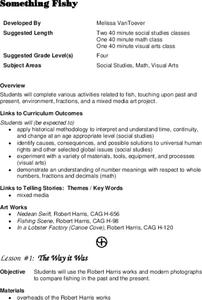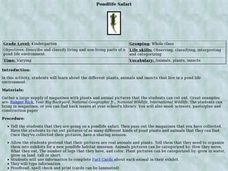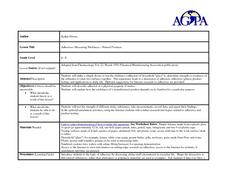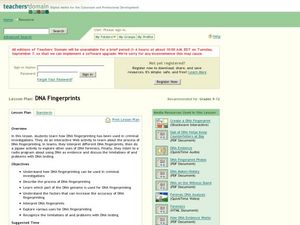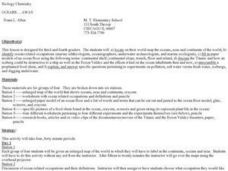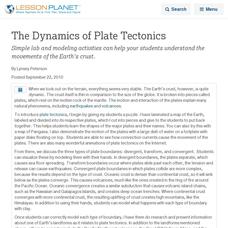Curated OER
Favorite Foods
Students draw a picture. In this favorite foods lesson, students list the foods they like to eat and form each like into a complete sentence. Students cut the word in the sentences apart and then arrange them in the correct order with a...
Curated OER
Something Fishy
Fourth graders study the Robert Harris works and modern photographs. They compare fishing in the past and the present. They use their knowledge of equivalent fractions to play a version of the game "Go Fish".
Curated OER
We Are Reflections of Canada - Our People, Our Places, And Our Landscape
Sixth graders discover that they are active participants in Canadian culture. They engage in investigation of the past and various symbols of Canada. They explore their concept of culture and demonstrate an understanding of culture...
Curated OER
Vertebrate Dioramas
Students are able to describe the development of their chosen form of vertebrate life from the past to the present in a four to six page typed paper. They explain the use of phylogenetic tree. Students use the phylogenetic tree to...
Curated OER
Vertebrate Dioramas
Students describe the development of their chosen form of vertebrate life from the past to the present in a four to six page paper. They explain the use of a phylogenetic tree, and use this to exemplify an organism's evolutionary change...
Curated OER
African American Concentration
Students study African American history month. In this culture activity, students discuss the origins of African American history and play a concentration game by matching the picture to the name of a famous African American.
Curated OER
Pond-life Safari
Students determine the living and non-living parts of pond life. In this pond life lesson plan, students examine the plants, animals, and insects that live in ponds. They look through a variety of print media, cut out pictures, and...
Curated OER
Breaking News English: Ukraine Gas Crisis
In this Ukraine gas crisis worksheet, students read the article, answer true and false questions, complete synonym matching, complete phrase matching, complete a gap fill, answer short answer questions, answer discussion questions,...
Curated OER
Adhesives: Measuring Stickiness
Students test the stickiness of natural substances. In this adhesion as a property of matter lesson, students build a tool to test the adhesion of natural "glues" such as honey, peanut butter, flour and water paste, and jelly. Students...
Curated OER
Earth Day
Students participate in activities that familiarize them with what Earth Day is, why it is important, and why it is a celebration.
Curated OER
The Energy Crisis
Students participate in different activities and discussions to analyze the energy crisis in the United States and other parts of the world. In groups, they research the availability of fossil fuels and the possible alternatives. Using...
Curated OER
Foods, Families, and Festivals
In this foods, families, and festivals worksheet, students cut out pictures of food, sort them in two groups of party foods and every day foods, and answer multiple questions about the uses of the foods. Students complete nine activities.
Curated OER
Pick a Pet
Students construct a pictograph of favorite pets. In this pets and graphing activity, students discuss their favorite pet and use animal magazines to find their favorite pets and cut them out. Students create a pictograph using the...
Curated OER
Technology: Koo Koo for Clocks
Third graders design and make clocks compiling a materials list, creating adesign portfolio, and recording progress in a daily log. After making a full-size drawing of their clocks and with the assistance of high school technology...
Curated OER
Rooster's Off To See the World Number-Sense
Students recognize how numbers are used in number stories. In this Rooster's Off To See the World lesson plan, students participate in the story. Students complete a number activity and work on the computer to illustrate a number...
Curated OER
DNA Fingerprints
Students interpret different DNA fingerprints, then do a jigsaw activity to explore other uses of DNA forensics. They listen to a radio program about using DNA as evidence and discuss the limitations of and problems with DNA testing.
Curated OER
Mini-Unit: Natural Resources
Students explore how their choices affect others. In this character development and ecology lesson, students debate choice-making issues. Students listen to The Lorax by Dr. Seuss and identify choices the characters made...
Curated OER
Put a Rainbow on Your Plate
In this nutrition worksheet, young scholars investigate the importance of eating fruits and vegetables of different colors 5 times a day. Students complete 8 pages of activities such as menu planning, shopping lists, word search, word...
Curated OER
Oceans Away
Young scholars explore oceans. In this science lesson plan, students locate oceans, seas and continents of the world, identify ocean-related occupations, and complete activities pertaining to food chains as well as pollution.
Curated OER
Review of the Five Senses
Students investigate the five senses. In this human biology lesson, students are given five items and identify which items match best with each of the senses. Students use objects such as a rock, hard candy, and a flower.
Curated OER
The Dynamics of Plate Tectonics
Simple lab and modeling activities can help your students understand the movements of the Earth's crust.
Curated OER
The Reel World
Students explore the ways in which the New York Times column 'Taking the Kids' analyzes whether or not current movies are appropriate for different ages of Students. They explore past articles from the column and create movie posters.
Curated OER
History In the House
Students analyze primary sources. In this historical analysis lesson, students will closely examine the household objects that most impact their lives. Students will use research, analysis, and class discussion to draw parallels between...
Curated OER
Animal Mix-Up #1 and #2
In these animal mix-up worksheets, students cut out parts of animals and then paste the parts together to form two complete animals. They identify the animal they have created (fish, seahorse, walrus, and whale). Students may color...

